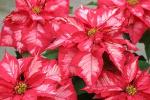COLUMBIA, Mo. – Red may be the traditional holiday choice for poinsettias, but a recent introduction to the floriculture world called “Ice Punch” will turn heads this season, according to David Trinklein, University of Missouri Extension horticulture specialist.
Ice Punch has large leaves of cranberry red highlighted by frosty white center markings.
Poinsettias are available in colors ranging from deeper and truer reds to pastel or “designer” colors aimed at complementing modern color schemes of homes. There is also a wide array of bicolored, speckled and novelty colors and bract shapes.
The poinsettia is the largest-selling potted flowering plant in the U.S., with the vast majority of the plants sold between Thanksgiving and Christmas.
Modern poinsettias flower earlier and last longer than older varieties. The colorful flowers actually are specialized leaves known as “bracts,” while the real flower is the yellow center, known as the cyathium.
Poinsettias are short-day plants that bloom only when receiving a critical duration of uninterrupted darkness—about 13 hours each day. In the Midwest, this happens about Sept. 25, which triggers the flowering response, Trinklein said. Today’s popular cultivars flower more quickly after sensing short days than cultivars of the past and are in full bloom by Thanksgiving.
To produce plants at the height of their attractiveness for late sales, conscientious growers delay the bloom of poinsettia by applying night-break lighting. This tricks the plant into thinking it is still summer and delays the initiation of flowering until night-break lighting is discontinued, usually early in October.
Trinklein notes that there is a common myth that the pretty plant is poisonous. Extensive testing by the Ohio State University resulted in a clean bill of health for the popular plant.
The history of the poinsettia
The poinsettia is named in honor of Joel Roberts Poinsett (1779-1851), who was the first United States ambassador to Mexico. He failed in his assignment to secure the purchase of Texas, but he did bring home colorful plants that Franciscan priests in the town of Taxco used in nativity processionals.
After its introduction to the United States, poinsettia was first important as a fresh cut flower and was a specialty of Albert Ecke, a German immigrant who grew cut flowers in southern California in the early 1900s. Upon his death, Ecke’s son, Paul, took over the family business and began the transformation of this species from an outdoor cut flower to a potted greenhouse plant.
Choosing a poinsettia
Trinklein offers tips for picking the perfect poinsettia:
• Look for crisp, healthy foliage and bright bracts.
• The cyathia should be tightly clustered and just starting to shed pollen.
• The potting medium should be moist but not overly wet.
• Avoid plants with symptoms of insect or disease infestation. Wilted or yellowing leaves are indicators of root disease.
How to keep the bloom
• Protect your poinsettia from wind and cool temperatures as you carry it to the car. If possible, put the plant in a sleeve or roomy bag to protect it and don’t keep it in the car while you shop.
• Keep the plant in indirect sunlight for at least six hours daily.
• Keep the room temperature between 60 and 72 degrees.
• Water the poinsettia when the soil feels dry to the touch. Soil should be wet, but not wringing wet.
• If excess water is collected in a saucer placed below the plant, be sure to empty the saucer to prevent the water from being reabsorbed into the growing medium.
• Keep the plant away from drafts and excessive heat. Do not place plants near appliances, fireplaces or ducts.
For more information about poinsettias, see the MU Extension publication “Care of Flowering Potted Plants” (G6511), available for free download at www.extension.missouri.edu/G6511.
Read more http://extension.missouri.edu/news/DisplayStory.aspx?N=1618





